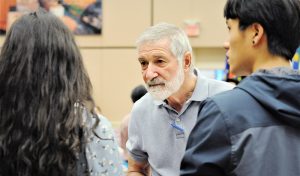After World War II, the United Nations was established in 1946 to “save succeeding generations from the scourge of war.”[1] Unfortunately, since then, some 250 armed conflicts have broken out around the world, claiming hundreds of millions of lives.
Conflict resolution, which aims to resolve tense situations between opposing parties peacefully, became a significant field of research in the latter half of the 20th century. Various theories of conflict resolution have evolved over the decades, ranging from avoidance and deterrence to compromise and collaboration.
The philosophy of Nichiren Buddhism, rooted in nonviolence and respect for all people, offers valuable insights that can be applied to conflict resolution and creating peace and harmony.
This Decade Is Crucial
In December 2019, Ikeda Sensei pointed to the significance of this decade, declaring:
The decade from the Soka Gakkai’s 90th anniversary to its centennial in 2030 will be crucial. We must be even more determined to show victorious proof of our own human revolution, to transform all great evil into great good and to effect a powerful change in the destiny of all humankind.[2]
Since then, we have faced unprecedented challenges, including the ongoing COVID-19 pandemic, racial injustice, mass shootings and the Russia-Ukraine war.
But Nichiren Daishonin writes, “When great evil occurs, great good follows.”[3] This is not to say that evil will naturally give rise to good. He teaches that we must use evil as a motivation to bring about great good amid turbulent times.
While global and interpersonal crises seem to persist and intensify, Buddhism teaches us how to transform evil into good and build a society of trust and mutual respect.
How can we become agents of change who can resolve conflicts on personal and societal levels?
Let’s look at three vital Buddhist perspectives that can help us act or take action as protagonists for peace:
1) Everyone is a Buddha, worthy of utmost respect.
2) Dialogue is the most powerful means of creating understanding and respect among people.
3) Our inner transformation is the key to changing the world.
Everyone Is a Buddha
Buddhism teaches that all life contains the potential for enlightenment and that each person is a Buddha worthy of the utmost respect.
We may readily agree with this point when we think about people who support us or share similar viewpoints. However, when faced with individuals who make us suffer, are cruel and unreasoning, or hold views starkly different from ours, we may seriously question whether everyone is a Buddha.
Yet, the basic premise of Nichiren Buddhism is that beyond our current or past actions, weak character traits or negative tendencies, each of us has a Buddha nature and that we have the potential to change and grow. Faith in this point drives our Buddhist practice, which helps deepen our belief in our own and others’ improvement.
Bodhisattva Never Disparaging is a figure from the Lotus Sutra who exemplifies this spirit. He famously approached every person he met, saying:
I have profound reverence for you, I would never dare treat you with disparagement or arrogance. Why? Because you will all practice the bodhisattva way and will then be able to attain Buddhahood.[4]
He sought to awaken each person to their inherent Buddha nature. Unfortunately, people sometimes responded negatively, shouting abuses and throwing sticks, stones and tiles at him. Undaunted, Never Disparaging continued to revere them, first retreating to a safe distance and then proclaiming they would attain Buddhahood.
In addition to teaching us to believe in the Buddha nature of all people, Never Disparaging exemplifies the spirit of perseverance. Sensei writes:
Even when vilified or injured, he never ceases to plant the seed of the twenty-four-character Lotus Sutra.[5] He continues struggling through all, having determined that this is how he will live regardless of other people’s reaction.[6]
Because he was determined to awaken everyone he encountered to their Buddha nature, Never Disparaging revealed his enlightenment and eventually led even those who had tried to harm him to Buddhahood.
In other words, every encounter—positive or negative—is an opportunity to deepen our belief in the Buddha nature of each person we meet, as well as our own.
And just as Never Disparaging evaded dangerous situations, there may be times when we need to remove ourselves from a harmful predicament. Yet no matter the circumstances, we can always chant Nam-myoho-renge-kyo for others to awaken to their Buddha nature. The key is that we strive to respect others as we engage in our Buddhist practice. Sensei says:
The Daishonin says, “It is like the situation when one faces a mirror and makes a bow of obeisance: the image in the mirror likewise makes a bow of obeisance to oneself.”[7]
Put another way, respect invites respect, and contempt breeds contempt. When we ourselves change, the other person changes, too.[8]
Challenging ourselves to believe in the Buddha nature of others simultaneously awakens our enlightened nature, helping us tap into our inherent wisdom, compassion and courage to create value in any situation.
Dialogue Is the Most Powerful ‘Weapon’ in Creating Peace
Buddhism considers dialogue the most potent “weapon” in resolving conflicts, whether on the individual, community or international level.
Nichiren Daishonin thoroughly believed this:
Nichiren’s faith in the power of language was absolute. If more people were to pursue dialogue in an equally unrelenting manner, the inevitable conflicts of human life would surely find easier resolution. Prejudice would yield to empathy and war would give way to peace. Genuine dialogue results in the transformation of opposing viewpoints, changing them from wedges that drive people apart into bridges that link them together.[9]
In genuine dialogue, the parties involved express their thoughts and hopes while listening to and learning from one another’s views and ideas.
Sensei explains how the use of coercion or violence only creates an unending cycle of conflict:
It may sometimes be possible to break an impasse through the use of military force or other forms of “hard power.” At best, however, such action can only respond to the symptoms of conflict; to the degree it plants further seeds of hatred in regions already torn by strife, it can deepen and entrench antagonisms.[10]
Dialogue is the only way to transform the root causes of conflict, as it contains the key to changing people’s hearts. But this is easier said than done. It requires the commitment of all involved to stay engaged until reaching a solid resolution.
Praising Socrates’ dedication to dialogue, Sensei writes:
In Socrates, we see the steadfast commitment to dialogue, to verbal combat from which there is no retreat, and an intensity that is, in some literal sense, “death defying.” Such dialogue can only be sustained by resources of spiritual energy and strength far greater and deeper than will be found among those who so quickly turn to violence.[11]
Sensei affirms that it takes a person of spiritual strength who is not prone to undue trust or unwarranted suspicion of others. “Our efforts for dialogue’s sake must be carried through to the end,” he says. “To refuse peaceful exchange and choose force is to compromise and give in to human weakness; it is to admit the defeat of the human spirit.”[12]
Shakyamuni Buddha expounded Buddhism, which rejects violence and teaches that dialogue is the most effective means for resolving conflicts. He exemplified this throughout his life.
In one story, toward the end of his life, the minister of his home kingdom of Magadha considered conquering the neighboring state of Vajji and sought Shakyamuni’s advice. Instead of admonishing the minister, Shakyamuni offered seven scenarios to demonstrate how all efforts through violence would fail. This discussion thwarted the planned attack.[13]
In Nichiren’s case, after submitting his treatise “On Establishing the Correct Teaching for the Peace of the Land,” he encountered several life-threatening attacks: the Matsubagayatsu Persecution,[14] Komatsubara Persecution[15] and Tatsunokuchi Persecution and Sado Exile.[16] He faced brutal force each time, yet he never resorted to violence.
Reducing the Poison of Anger
Nichiren teaches that the three calamities of famine, pestilence and warfare spring from the three poisons of greed, foolishness and anger. He states, “Famine occurs as a result of greed, pestilence as a result of foolishness and warfare as a result of anger.”[17]
Sensei comments on this last point about anger:
There is a terrible destructive force in the fiery magma of anger that wells up at frustration, discrimination, betrayal, insult or exploitation by others. When that suppressed negative energy explodes, it can manifest as violence or aggression and even escalate into warfare. These eruptions of hatred and malice in the forms of nationalism or of economic, ideological or religious conflict are often the cause of war and armed conflict in our present age.[18]
The effort to create a truly peaceful and harmonious society begins with ourselves addressing the anger in our hearts.
Buddhism opposes all forms of violence because when anger is met with more anger, it proliferates. And the use of force only creates a cycle of vengeance and further violence. So how do we rid ourselves of the three poisons, anger included?
Simply put, chanting Nam-myoho-renge-kyo enables us to bring forth limitless inner strength, confidence and wisdom to use our anger as a catalyst for our inner transformation.
Responding to anger or violence with dialogue may seem counterintuitive. The side that chooses dialogue may seem weaker. But in looking at the examples of Shakyamuni and Nichiren, we can see the humanism and effectiveness of their ways.
Mahatma Gandhi said: “Nonviolence is the greatest force at the disposal of mankind. It is mightier than the mightiest weapon of destruction devised by the ingenuity of man.”[19]
By rejecting violence and always choosing the path of dialogue, we will transform our anger into the determination, wisdom and creativity necessary to resolve conflicts in a way where all parties win.
Through our Buddhist practice, we can become masters of conflict resolution in our families, workplaces or greater society. We can learn to diffuse frustration, anger and tension by chanting Nam-myoho-renge-kyo for the happiness and best solution for all parties, learn how to recognize the Buddha nature in others and engage in value-creative dialogues.
Having conducted more than 1,600 dialogues with leading world figures, Sensei exemplifies how to create value and mutual understanding among peoples and groups with differing views. He writes about becoming a protagonist of peace:
Great good can come of great evil. But this will not happen on its own. Courage is always required to transform evil into good. Now is the time for each of us to bring forth such courage: the courage of nonviolence, the courage of dialogue, the courage to listen to what we would rather not hear, the courage to restrain the desire for vengeance and be guided by reason.[20]
No matter how seemingly hopeless the times become, let’s continue practicing Buddhism day after day with the spirit “Still I am not discouraged,”[21] and consistently bring forth the inherent goodness in ourselves, others and the world.
References
- https://www.un.org/en/about-us/un-charter <accessed on June 16, 2022>. ↩︎
- September 18, 2020, World Tribune, p. 3. ↩︎
- “Great Evil and Great Good,” The Writings of Nichiren Daishonin, vol. 1, p. 1119. ↩︎
- The Lotus Sutra and Its Opening and Closing Sutras, p. 308. In Kuamrajiva’s Chinese translation of the Lotus Sutra, this passage consists of 24 characters and is known as the twenty-four-character Lotus Sutra. ↩︎
- Twenty-four-character Lotus Sutra. See footnote 4. ↩︎
- The Wisdom of the Lotus Sutra, vol. 5, pp. 100–01. ↩︎
- The Record of the Orally Transmitted Teachings, p. 165. ↩︎
- WLS-5, 114–15. ↩︎
- A New Way Forward, p. 43. ↩︎
- 2004 Peace Proposal “Inner Transformation: Creating a Global Groundswell for Peace,” https://www.worldtribune.org/peace-proposal/inner-transformation-creating-a-global-groundswell-for-peace-2004/ <accessed on June 16, 2022>. ↩︎
- A New Way Forward, p. 32. ↩︎
- Ibid., 33. ↩︎
- See Ibid., 41–42. ↩︎
- Matsubagayatsu Persecution: An attempt on Nichiren Daishonin’s life by Nembutsu followers and others at his dwelling at Matsubagayatsu in Kamakura in 1260. ↩︎
- Komatsubara Persecution: An ambush in 1264 on the Daishonin and some of his disciples at Matsubara in Tojo Village. He suffered a sword cut to his forehead and broken hand, and one of his disciples was killed while another later died of injuries sustained. ↩︎
- Tatsunokuchi Persecution: An unlawful attempt to execute Nichiren Daishonin at Tatsunokuchi in Kamakura on September 12, 1271. Shortly after that, based on false charges, he was sentenced to exile on Sado Island. The exile lasted for two years and five months, from the end of October 1271 until his pardon in March 1274. ↩︎
- “King Rinda,” WND-1, 989. ↩︎
- The Teachings for Victory, vol. 2, p. 137. ↩︎
- “The Power of Nonviolence,” https://www.mkgandhi.org/nonviolence/phil2.htm <accessed on June 16, 2022>. ↩︎
- “The Courage of Nonviolence,” https://www.daisakuikeda.org/main/peacebuild/essays-on-peace/p-nonviol.html <accessed on June 16, 2022>. ↩︎
- “The Essentials for Attaining Buddhahood,” WND-1, 748. ↩︎
You are reading {{ meterCount }} of {{ meterMax }} free premium articles





